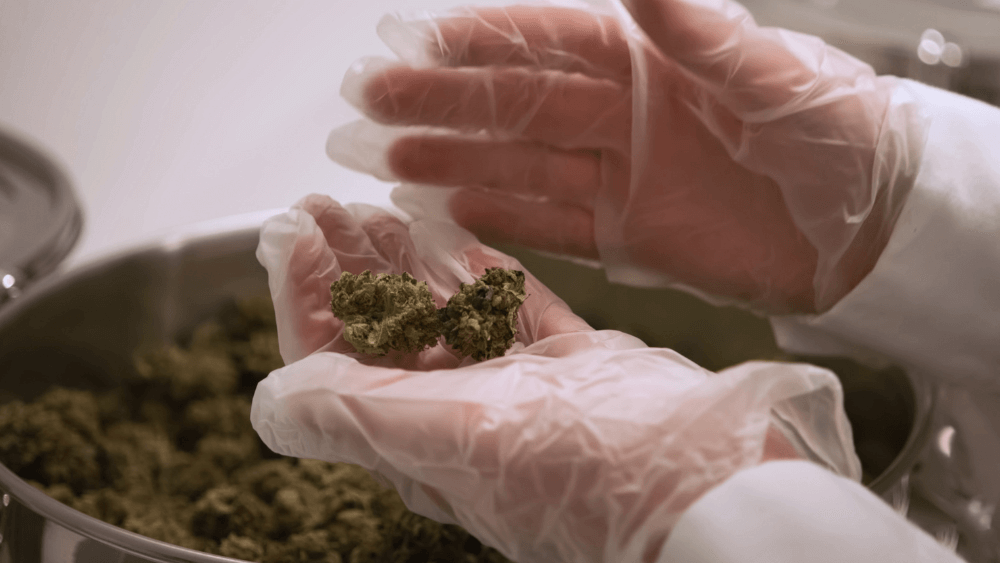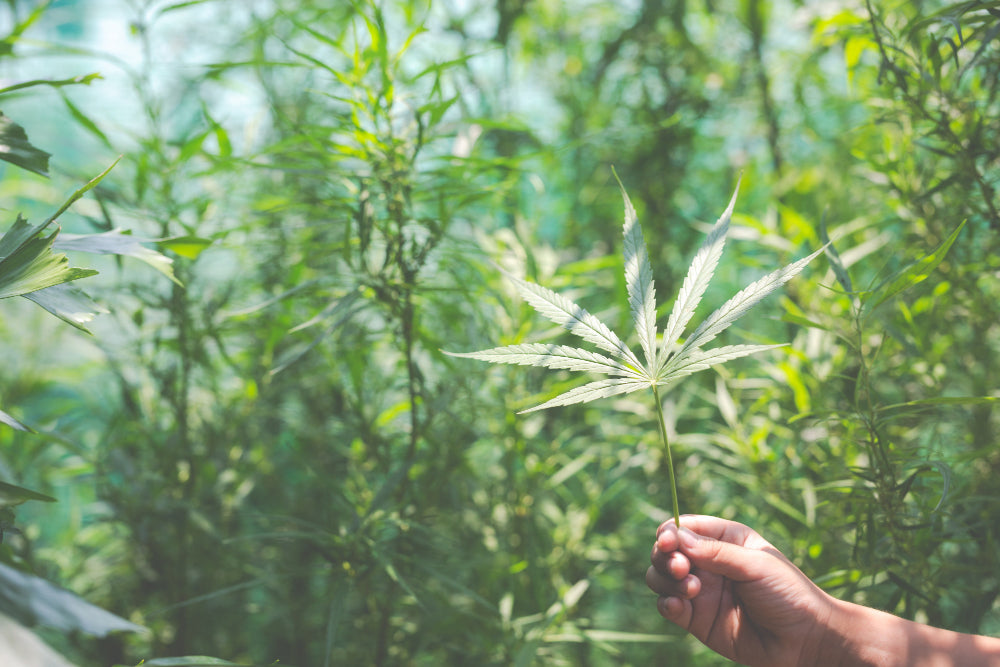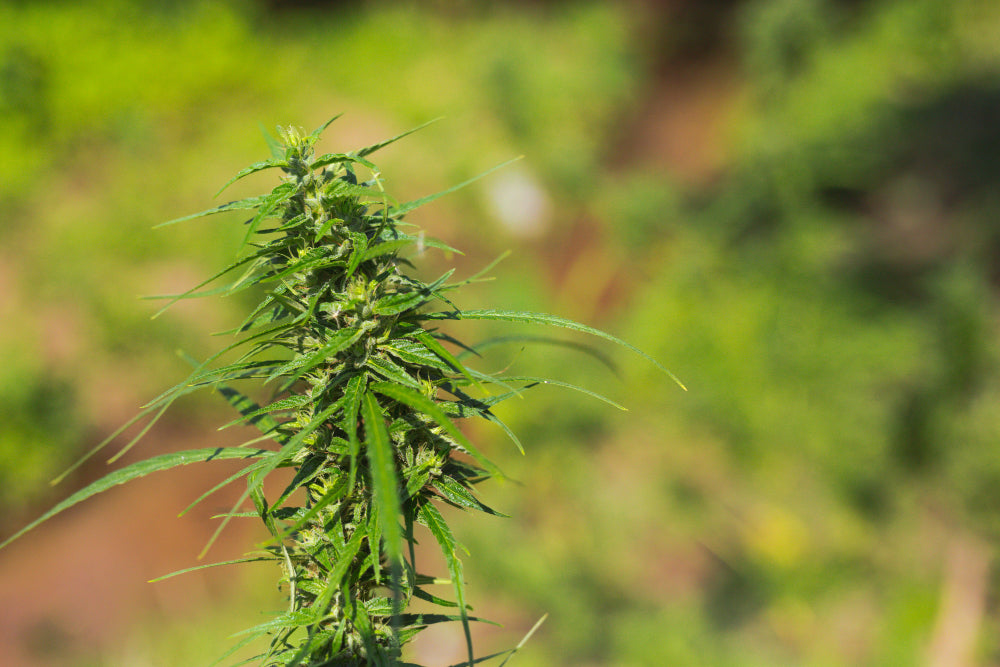THC-B - what is it?

Inhaltsverzeichnis
In the ever-expanding world of cannabinoids, we welcome a new, exciting player: THC-B. This relatively unknown molecule could soon emerge from the shadow of its famous relatives and open up new perspectives in therapeutic applications. Let's discover together what makes THC-B (tetrahydrocannabutol) so special and why it is more than just another cannabinoid.
What is THC-B?
Tetrahydrocannabutol (THC-B) is an emerging cannabinoid that has a unique chemical structure that sets it apart from tetrahydrocannabinol (THC), the most well-known psychoactive component of the cannabis plant. These structural differences are not only intriguing at the molecular level, but could also have important implications for the therapeutic use of THC-B by opening new avenues in the treatment and understanding of cannabinoids.
THC-B and its Unique Chemical Structure
The chemical composition of THC-B differs from THC by a variation in the length of the alkyl side chain. While THC has a pentyl chain (five carbon atoms long), THC-B has a butyl chain (four carbon atoms long). This seemingly minor change has profound effects on the way the molecule binds to the CB1 and CB2 receptors in the human body's endocannabinoid system. This different binding ability is believed to give THC-B potentially unique properties in terms of the intensity and nature of its effects compared to THC.
Differences and similarities with other cannabinoids
THC-B shares many properties with other cannabinoids, particularly THC, as both bind to the same receptors in the body and can have similar mechanisms of action. Nevertheless, preliminary research suggests that the specific structure of THC-B could result in a different efficiency or affinity for these receptors, which in turn could influence its psychoactive properties and therapeutic uses.
Compared to cannabidiol (CBD), another prominent cannabinoid that does not possess psychoactive effects, THC-B may occupy an intermediate position, providing therapeutic benefits without necessarily inducing the same psychoactive effects as THC. This balance between effectiveness and side effect profile makes THC-B a particularly interesting candidate for further research.
The study of the interactions between THC-B and the endocannabinoid system is still in its early stages, but the uniqueness of its structure compared to other cannabinoids such as THC and CBD suggests great potential. Researchers are particularly interested in how THC-B could expand the therapeutic landscape by providing alternatives or complements to existing cannabinoid-based treatments.
THC-B's potential to provide similar or even enhanced therapeutic effects compared to THC without causing the same psychoactive side effects makes it a promising candidate for the future development of cannabinoid-based therapies. Research is still in its early stages, and extensive studies are needed to fully understand the exact mechanisms of action, potential therapeutic uses, and long-term effects of THC-B. But evidence so far suggests that THC-B has the potential to change the way we think about and use cannabinoids.
The effect of THC-B
Unique mode of action in the body
THC-B is characterized by its remarkable ability to interact with the body's endocannabinoid system (ECS). This specific interaction gives THC-B potentially unique therapeutic properties that set it well apart from other cannabinoids. The ECS plays a critical role in maintaining the body's internal balance by regulating a variety of functions, including pain sensation, inflammatory responses, sleep, mood, and more. By interacting with this system, THC-B may be able to influence these functions in a way that can be used for therapeutic purposes.
THC-B's special structure may allow it to bind more strongly or selectively to the CB1 and CB2 receptors distributed throughout the body. These receptors are key components of the ECS and play a central role in mediating the effects of cannabinoids. By modulating these receptors, THC-B could achieve targeted therapeutic effects that could be useful in treating various conditions and symptoms.
Interaction with the endocannabinoid system
The exact way in which THC-B interacts with the CB1 and CB2 receptors is a current research topic. These interactions are of particular interest as they may shed light on how THC-B could potentially contribute to the development of new therapeutic approaches. Evidence to date suggests that THC-B has an affinity for these receptors that is different from that of other cannabinoids. These differences in binding affinity and selectivity may explain why THC-B can produce unique effects in the body.
A better understanding of the interactions between THC-B and the endocannabinoid system could have far-reaching implications for medical research and the development of new treatments. For example, it might be possible to modify or use THC-B to affect specific parts of the ECS in a way that is particularly beneficial for certain medical conditions or symptoms. Additionally, research on THC-B could help expand knowledge of the ECS itself, which in turn could support the development of therapies for a wide range of diseases related to this complex system.
Overall, THC-B shows great potential for medical research and application, particularly through its unique interaction with the endocannabinoid system. Future research will hopefully shed more light on the specific mechanisms by which THC-B works and how these can be exploited for therapeutic purposes.
Benefits and Uses of THC-B
THC-B, or tetrahydrocannabutol, offers an intriguing prospect in the field of medical cannabinoids by offering similar therapeutic benefits to THC, but with one key difference: it has the potential to cause significantly fewer psychoactive side effects. This property makes THC-B particularly attractive for medical research and could make it a preferred choice for patients and physicians seeking the therapeutic benefits of cannabinoids without the intense psychoactive effects.
Comparison of therapeutic effects with THC
Compared to THC, THC-B may offer a gentler alternative that is suitable for a broader patient group. Particularly for people who are sensitive to or have concerns about the psychoactive effects of THC, THC-B offers a promising solution. The ability to relieve pain, reduce inflammation and improve sleep without severely impairing cognitive function could make THC-B a key element in the future treatment of many conditions.
Possible medical applications
Pain relief
One of the outstanding potentials of THC-B lies in pain therapy. Similar to other cannabinoids, THC-B shows promising properties in relieving chronic pain. It could prove particularly useful in cases where traditional painkillers are either ineffective or cause unwanted side effects. THC-B's specific interaction with the endocannabinoid system could provide more effective pain relief, with a lower risk of psychoactive side effects.
Support for sleep disorders
The potentially relaxing properties of THC-B could make it a valuable aid for those with sleep disorders. By promoting relaxation and improving sleep quality, THC-B could provide a natural alternative to traditional sleep aids, which are often associated with a range of side effects.
Anti-inflammatory properties
The anti-inflammatory effects of THC-B open up new possibilities in the treatment of inflammatory diseases. By reducing inflammation, THC-B could help relieve symptoms of conditions such as arthritis, Crohn's disease and other inflammatory conditions, without the psychoactive effects associated with THC.
Potential applications in cancer therapy
Although research on THC-B in oncology is still in its early stages, early studies suggest that it has the potential to improve the quality of life of cancer patients. This includes relieving pain, reducing nausea and stimulating appetite, which can be particularly beneficial in patients undergoing chemotherapy.
Research into THC-B and its potential applications is still in its early stages, but findings to date point to a wide range of therapeutic possibilities. With further research and development, THC-B could play a central role in the future of cannabinoid medical treatment by providing effective solutions for a variety of patients seeking the benefits of cannabis without the psychoactive side effects.
Is THC-B legal?
The legality of THC-B, a relatively new cannabinoid derived from the cannabis plant, is a complex issue that is closely tied to local and national drug laws. In some areas where cannabis and its derivatives have been legalized for medical or recreational purposes, THC-B could potentially fall under these legal categories. However, the legal situation is not the same everywhere and is subject to constant change, which poses a challenge for those interested in understanding the current status of THC-B.
The distinction between THC-B and other cannabinoids, such as the well-known THC (tetrahydrocannabinol) and CBD (cannabidiol), plays a crucial role in assessing its legality. While CBD is relatively widely accepted and legal in many parts of the world due to its non-psychoactive properties, THC is strictly regulated in many countries due to its intoxicating effects. Since THC-B shares structural similarities with THC, its classification and therefore its legality could be directly influenced by these comparisons. What is crucial here is how the respective legal systems assess the psychoactive properties and the potential for medical applications of THC-B.
Another important aspect is that the legal framework for cannabinoids is constantly evolving. New scientific findings and changing public perceptions of cannabis and its derivatives may lead to adjustments in legislation. This means that the legality of THC-B may look different today than it will in a few months or years. It is therefore essential for people interested in using THC-B to regularly keep themselves informed about the latest legal developments.
Conclusion
The world of cannabinoids is rich and diverse, and the discovery of THC-B adds a new dimension to this fascinating universe. Although research on this specific cannabinoid is still in its infancy, what is known to date suggests that THC-B has the potential to enrich and expand the therapeutic uses of cannabis. It represents the almost infinite diversity and potential of the cannabis plant and highlights the importance of continued research in this area.
The future of THC-B
The discovery of THC-B sheds light on the need to remain open and curious when it comes to researching the cannabis plant and its many components. The dynamic field of cannabinoid research continually offers new insights and opportunities to advance our understanding of health and well-being. By unlocking the secrets of substances like THC-B, we can not only develop new therapeutic options, but also deepen our knowledge of the natural resources available to us.
The potential for THC-B to take a permanent place in the range of therapeutic cannabinoids is an exciting prospect. It symbolizes the limitless possibilities that can arise from the combination of nature and science and reminds us that there is still much to be discovered. The future of THC-B and other cannabinoids depends on further research, the development of new technologies, and society's willingness to use these natural resources in a responsible and innovative way.





